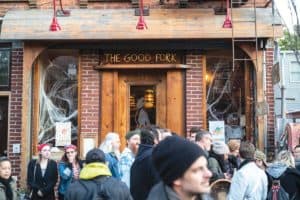
On the streets of Red Hook on October 29, the iconic Japanese sea monster Godzilla took on his fiercest opponent yet: extreme weather. He won, saving the neighborhood from a second natural disaster and keeping its citizens dry and happy over the course of the Barnacle Parade, which has annually celebrated local resilience since the first anniversary of Hurricane Sandy.
Red Hook’s volunteer-built Godzilla stood over 25 feet high (setting a Barnacle record), a colossus of landscape fabric, plywood, two-by-fours, and chicken wire, pulled by a team of at least seven, with additional children holding up the tail, plus some internal puppeteers. The lifelike creature could swing his arms, bend at the waist, crane his neck, and even breathe smoke from his red-illuminated mouth. The hurricane – a shopping cart adorned in blue parachute cloth, PVC, and upholstery batting – kept its distance.
Led by drummers, a trumpeter, and a saxophonist, with stops for free snacks and beverages at Steve’s Authentic Key Lime Pies, Hometown Bar-B-Q, and the Good Fork, and followed by a block party at Van Brunt and Pioneer streets, the parade had the loose, inclusive informality of a New Orleans second-line, aided by a reasonably minimal police presence and plenty of maritime costumes: lobsters, mermaids, hermit crabs, flotsam. A woman dressed as a radioactive fish said that “the kids and the dogs” were always the best part. A trio from PortSide New York carried jumbo-sized teardrops. Famous enough in its sixth year to draw some curious outsiders, the Barnacle Parade remains largely a community-based gathering of oddballs, immersed in the memory of the disaster that inspired it. “This shows that we’re never going to be beat by another storm. Red Hook will always win,” said resident Lisa Gonzalez.


Organized by a “non-organization organization” (as co-founder Ben Schneider put it) that meets at Sunny’s Bar, the self-funded event subsists on profits from souvenir T-shirts, printed at cost by Fulla Shirts, with a new design selected from a pool of submissions each year. Since 2017, donated gift baskets have allowed for raffle ticket sales, whose revenue goes toward hurricane relief efforts: last year, for Puerto Rico; this year, for North Carolina and Florida. World Central Kitchen, which provides meals for victims of natural disasters, will receive the donation.
2018’s float bore the heart-shaped insignia “B+T” to mark the January demise of the beloved Bait & Tackle, which had stayed open after Sandy and served as “the hub, the center of survival, the center of comfort and warmth,” according to former manager Robbie Giordano, for the otherwise paralyzed neighborhood. This September, a Guardian article posited climate change and gentrification as dual existential threats to Red Hook. Hally McGehean, whose young daughter wore a Barry O’Meara mask in honor of the fallen bar’s owner, explained: “For us, the Bait & Tackle was the heart of Red Hook in the year following Sandy, and it definitely feels like the end of an era having it gone, and we’re glad that the parade is still going on.” Giordano pointed out that, just two days before the 2018 parade, a Saturday nor’easter had left a foot of floodwater in some parts of Red Hook.
“The community gets to survive something like Sandy, or whatever hits us, if we know each other, if there’s strong bonds and relationships,” City Councilman Carlos Menchaca observed at the parade. “And we’re just maintaining those relationships as we remember that dark day that was Sandy.”
[slideshow_deploy id=’6134′]









